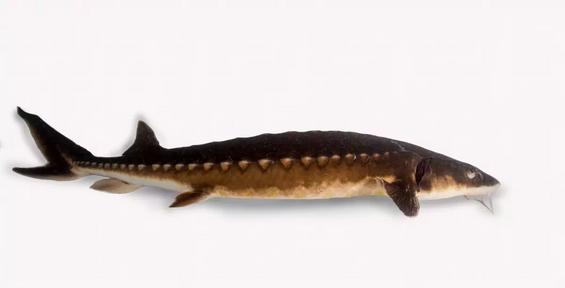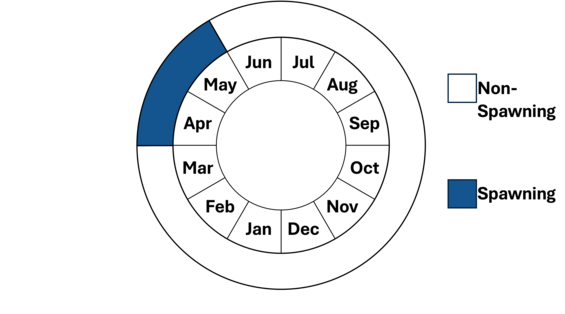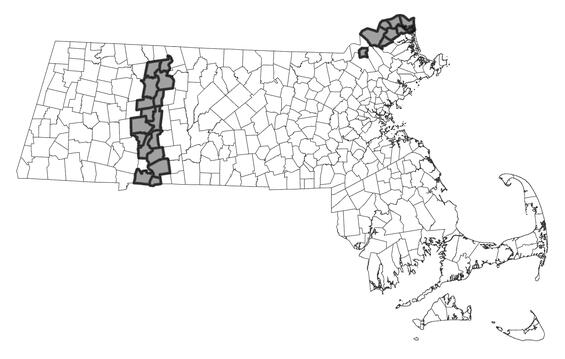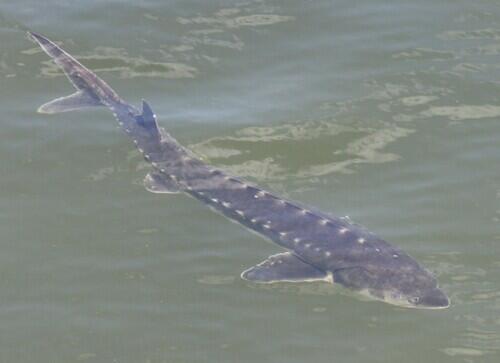- Scientific name: Acipenser brevirostrum
- Species of Greatest Conservation Need (MA State Wildlife Action Plan)
- Endangered (MA Endangered Species Act)
- Endangered (US Endangered Species Act)
Description

Shortnose sturgeon (Acipenser brevirostrum)
The shortnose sturgeon is one of the smallest species of sturgeons, growing no larger than 1.4 m (4.5 ft) in length and up to 27 kg (60 lbs). Adults possess a short, blunt, rounded snout with four fleshy barbels and inferior mouth. The species has five rows of bony plates called scutes along the body (dorsally, laterally, and ventrally) and modified armored scales on the head giving it a skull-like appearance. The shortnose sturgeon has a yellow-brown to blackish-olive dorsal surface, pale-colored scutes, and a white underside.
The shortnose sturgeon can be confused with the larger Atlantic sturgeon. Features that distinguish these species include the shortnose sturgeon’s lack of scutes between the base of anal fin and lateral row of scutes, and wider mouth relative to interorbital width.
Life cycle and behavior

Shortnose sturgeon spawning runs occur every year, but individuals may spawn only once every two to three years with males having shorter spawning intervals than females. In Massachusetts, the spawning runs usually occur in April to early May driven primarily by photoperiod with males reaching spawning sites before females. Spawning occurs at specific freshwater, natal sites, over rocky substrates with moderate bottom velocities. The eggs are very adhesive and attach to rocks and plants. After hatching the free embryo is photosensitive seeking shelter under rocks or other cover. With rapid development and growth forming into larvae, individuals disperse downstream from their spawning site and start feeding. After overwintering in freshwater, and developing a salinity tolerance, yearling sturgeon migrate downstream to the freshwater-saltwater zone. Juvenile and adult sturgeon will make complex seasonal movements within freshwater and estuarine habitats within and outside of non-natal systems presumably seeking food resources, predators, temperature, and flow refuge. These refuges are often in relatively concentrated segments or reaches of the river. Further research shows pre-spawning individuals overwintering in the Merrimack River make 200-250 km spring migrations to the Kennebec River spawning site in Maine. In the Connecticut River, pre-spawning females make summer and fall migrations close to Montague spawning sites and make a final migration in the following spring to spawn.
Female shortnose sturgeons do not reach maturity until they are 10-12 years old, with males reaching maturity a few years younger. Individuals may live up to 27 years or longer; the record is 67 years for females and 32 years for males. Shortnose sturgeons are benthic feeders, using their extendable lips to siphon or vacuum prey items in and along the substrate. Young individuals eat insects and crustaceans, while adults eat a variety of foods including small mollusks, insect larvae, and crustaceans.
Population status
The shortnose sturgeon is listed as endangered in Massachusetts and federally by the United States Fish and Wildlife Service. As with all species listed in Massachusetts, individuals of this species are protected from take (collecting, killing, etc.) and sale under the Massachusetts Endangered Species Act.
Distribution and abundance

Distribution in Massachusetts. 2000-2025. Based on records in the Natural Heritage Database.
The shortnose sturgeon range extends from Florida to New Brunswick in major river and estuarine systems. In Massachusetts shortnose sturgeon populations occur in the Connecticut and Merrimack Rivers. The Connecticut River population is composed of a segmented population fragmented by the Holyoke Dam. Recent efforts have improved upstream passage for sturgeons to reach its historical spawning site in Montague, however, reproduction success and survival of early life stages is severely limited by flow regulation at the Turner’s Fall Dam. The impending implementation of new flow regulations aims to improve spawning conditions and early life stage survival. Spawning has also occurred downstream of Holyoke Dam in recent years. Population estimates above and below Holyoke Dam range are 328 and 1600 individuals respectively, although those estimates are from more than ten years ago. In the Merrimack River, shortnose sturgeon habitat is severely constrained by the Lawrence Dam, the most downstream dam on the Merrimack River. Evidence of reproduction has been documented, with a known spawning site suggesting the population size is relatively small. However, recent side scan sonar surveys found about 3,000-4,000 sub-adults and adults overwintering in the Merrimack River, where a portion are likely residents and others migrate in the spring to spawning sites in nearby rivers in the Gulf of Maine. Shortnose sturgeon may also visit other small coastal estuaries around the Massachusetts shoreline seeking food resources.
Habitat
The shortnose sturgeon is an amphidromous species, using both freshwater big river habitats and saltwater estuarine and coastal habitats throughout their lifespan. In Massachusetts, populations are mostly riverine, although estuaries and coastal areas are used for foraging and as migration corridors between river systems. In the Merrimack and Connecticut Rivers, shortnose sturgeon have spawning sites, overwintering reaches, and foraging reaches. Known spawning sites are characterized by cobble and pebble substrate with moderate currents. Overwintering reaches are often in deeper waters (e.g., >4 m ; >13 ft) and lower velocities to preserve energy. Foraging habitat is varied but often composed of sandy and muddy substrates at widely varying depths from thalwegs to shoals.
Healthy habitats are vital for supporting native wildlife and plants. Explore habitats and learn about conservation and restoration in Massachusetts.
Threats
The primary threats to shortnose sturgeon include no or limited fish passage above dams, streamflow alteration predominantly from hydropower facilities, bridge and riverbank construction activities, river channel dredging, water quality degradation from industrial and sewage discharge, agricultural runoff, and other environmental contaminants, and commercial and recreational fishing. These threats reduce habitat availability, degrade habitat quality, disrupt shortnose sturgeon migrations and aggregating behaviors, and cause direct mortality. In addition, sea level rise from climate change may further reduce available freshwater habitat that is already constrained by impassable barriers for sturgeon. Shortnose sturgeon are particularly vulnerable to these threats because sexual maturity is reached after multiple years, spawning occurs periodically, and they migrate over long distances to reach critical habitats.
Conservation
Survey and monitoring

Shortnose sturgeon (Acipenser brevirostrum)
Shortnose sturgeons are monitored through survey efforts by federal (USGS) and state agency partners (Connecticut DEEP), at dam passage facilities primarily the Holyoke Dam on the Connecticut River, and during in-water construction activities. Survey efforts often tag suitable individuals for future tracking. Side scan sonar has been successfully implemented to detect and estimate the abundance of shortnose sturgeon aggregations in Massachusetts waters.
Management
Protection and restoration of shortnose sturgeon habitat and mortality minimization are critical for shortnose sturgeon persistence and recovery. This is achieved by working with state and federal partners, conservation organizations, and hydroelectric companies to improve passage at dams, and improve streamflow and habitat conditions to promote shortnose sturgeon reproduction success, early life stage survival, and prevent sturgeon mortalities. Further stress and mortality are avoided during in-water construction activities (e.g., dredging, riverbank work, bridge construction) through the development of shortnose sturgeon protection plans.
Research needs
Research efforts needed are numerous but examples include: identifying and characterizing nursery river reaches used by early life stages; characterizing river habitat (e.g., substrate, flow) throughout the species' historical range; estimating freshwater habitat loss with projected upstream advancement of salt-water intrusion particularly in the Merrimack River; estimating spawning run sizes in Merrimack and Connecticut River populations; estimating survival and movement of shortnose sturgeon after passing major dams (e.g., Holyoke Dam); evaluating shortnose sturgeon early life stage survival, particularly after implemented changes in regulated streamflows; updating distribution and habitat use in non-natal coastal rivers; characterizing population genetic structure in Massachusetts waterbodies.
References
Kieffer, M. C., & Kynard, B. 1993. Annual movements of shortnose and Atlantic sturgeons in the Merrimack River, Massachusetts. Transactions of the American Fisheries Society 122:1088–1103.
Kieffer, M. C., & Kynard, B. 1996. Spawning of the shortnose sturgeon in the Merrimack River, Massachusetts. Transactions of the American Fisheries Society, 125(2), 179–186.
Kieffer, M. C.; Kynard, B., 2012a: Pre-spawning and non-spawning spring migrations, spawning, and effect of river regulation and hydroelectric dam operation on spawning of Connecticut River shortnose sturgeon. WSCS Spec. Publ. No. 4. pp. 73–113.
Kieffer, M. C.; Kynard, B., 2012b: Wintering of Connecticut River shortnose sturgeon. WSCS Spec. Publ. No. 4. pp. 129–163.
Kieffer, M. C.; Kynard, B., 2012c: Long-term evaluation of telemetry tagging on shortnose sturgeon. WSCS Spec. Publ. No. 4. pp. 297– 320.
Kieffer, M. C.; Kynard, B.; Seibel, D., 2012: Foraging and wintering ranges and the effect of tidal and diel cycles on movement of shortnose sturgeon with a note on sub-adult Atlantic sturgeon. WSCS Spec. Publ. No. 4. pp. 115–127.
Kynard, B., Bolden, S., Kieffer, M., Collins, M., Brundage, H., Hilton, E. J., Litvak, M., Kinnison, M. T., King, T., & Peterson, D. 2016. Life history and status of shortnose sturgeon (Acipenser brevirostrum LeSueur, 1818). Journal of Applied Ichthyology 32:208-248.
Kynard, B.; Kieffer, M.; Horgan, M.; Burlingame, M.; Vinogradov, P.; Kynard, B. E., 2012a: Seasonal movements among river reaches, migration strategies, and population structure of the divided Connecticut River shortnose sturgeon population: The effects of Holyoke Dam. WSCS Spec. Publ. No. 4. pp. 1–49.
Kynard, B.; Kieffer, M.; Burlingame, M.; Vinogradov, P.; Kynard, B. E., 2012b: Demography, movements, spawning habitat, and spawning success of Connecticut River shortnose sturgeon migrating to Holyoke Dam. WSCS Spec. Publ. No. 4. pp. 51– 72.
Kynard, B.; Kieffer, M.; Parker, E.; Pugh, D., 2012c: Lifetime movements by Connecticut River shortnose sturgeon. WSCS Spec. Publ. No. 4. pp. 227–242.
Wippelhauser, G. S., Zydlewski, G. B., Kieffer, M., Sulikowski, J., & Kinnison, M. T. (2015). Shortnose sturgeon in the Gulf of Maine: Use of Spawning Habitat in the Kennebec System and Response to Dam Removal. Transactions of the American Fisheries Society, 144(4):742–752.
Contact
| Date published: | April 8, 2025 |
|---|